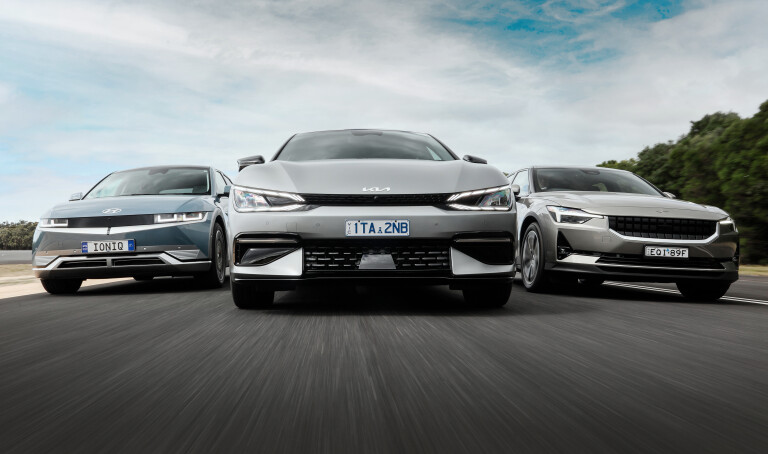
If hype were a power source, the Hyundai Ioniq 5 and Kia EV6 would be fully charged before getting anywhere near a plug point.
While the Korean brands’ first electrified efforts – the (unrelated) Ioniq sedan and Niro SUV, respectively – flew somewhat under the radar, their first vehicles to sit on a dedicated EV platform are stylistically driven, head-turning blips that have stirred the internet.
The Ioniq 5 landed last year in a blaze of retro-futuristic glory and its limited allocation sold out within hours. It’s no easier to get your hands on Kia’s swoopier, curvier version, with Australia’s 2022 EV6 supply currently limited to 500 against a backdrop of consumer eagerness that saw expressions of interest thrash those of the company’s previous halo model, the Stinger sedan.

Pricing and Features
Context is also needed for pricing. Both EVs are much bigger than pictures suggest – closer to large than mid-sized – and, in the current industry climate, demonstrating technological credentials and achieving healthy margins is a greater focus for manufacturers than volume. So, if any hopes had been held out that the brand once renowned for budget-priced motoring might lead the way for affordable electric cars, the EV6 dashes those with a starting cost of $67,990 before on-road costs.
The base Air undercuts the $71,900 (before on-road costs) entry fee to the Ioniq 5, at least – crucially making it eligible for the generous $3000 rebates offered on top of stamp duty exemptions in New South Wales and Victoria.
Our variants here, though, are the EV6 GT-Line AWD and Ioniq 5 AWD that are holding fort as range flagships until the arrival of performance versions that will be respectively badged GT and N.
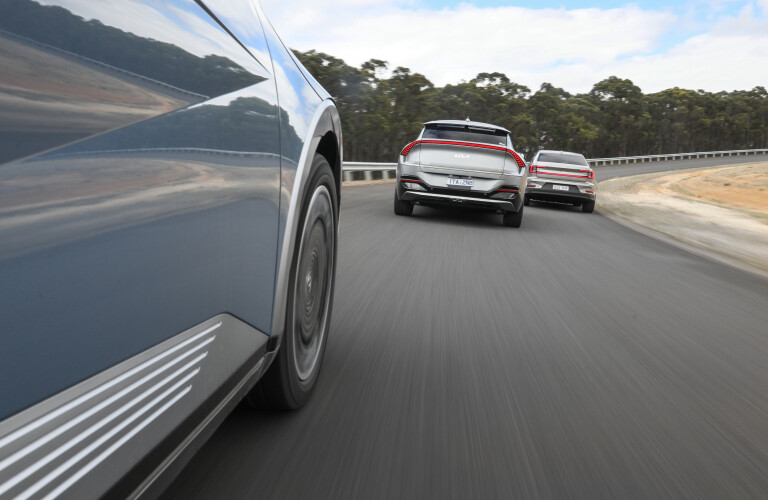
A straight fight between this desirable duo would have been fascinating alone, yet there’s another highly intriguing battery electric vehicle that has just arrived in Australia with similar ambitions to woo the tech crowd away from the industry’s Other Big T.
Not just a new car; a new brand. Polestar was originally a motorsport skunkworks outfit for Volvo and less than a decade ago was being developed as Volvo’s answer to BMW M and Mercedes-AMG, but it has since been upgraded to standalone-brand status.
Polestar was originally a motorsport skunkworks outfit for Volvo, but has since been upgraded to standalone-brand status

With Australia forced to skip the left-field, limited-volume and left-hand-drive Polestar 1 GT that will also forever be the odd model out as a hybrid vehicle, the Polestar 2 fastback arrives as the first proper global model for the company co-owned by Volvo and its own parent, China’s Geely.
Volvo’s sub-brand is pointing to expressive design, innovation and driving dynamics as key differentiators for its models. Contentiously, perhaps, Polestar is taking a different approach to safety.
To achieve price parity with the $59,900 Tesla Model 3 base model, the 2’s standard equipment misses driver-assistance systems standard on its more expensive technical twin, the XC40 Pure Electric.
In a global approach, Polestar instead groups assistance systems (including adaptive cruise control, blind-spot monitoring, cross-traffic alert and a surround-view camera) in a $3400 Pilot Lite Pack. Our $64,900 mid-grade Long Range Single Motor test vehicle included this pack along with a $6000 Plus Pack that adds a raft of luxury and convenience features. Again, all these prices exclude on-road costs.

Both packs are needed to get the Swedish EV up to equipment speed with its Korean rivals; for actual performance parity as well, buyers need a minimum of $69,900 plus on-road costs for the Dual Motor Long Range.
That gives the dual-motor Ioniq 5 a value head-start, with the $75,900 (before on-road costs) Hyundai bringing all-wheel drive for just $1600 more than our as-tested front-drive Polestar 2.
The Kia, perhaps surprisingly, also needs to make up ground because while the EV6 GT-Line AWD is (almost) technically identical to the Hyundai, it’s priced at $82,990 before on-road costs.
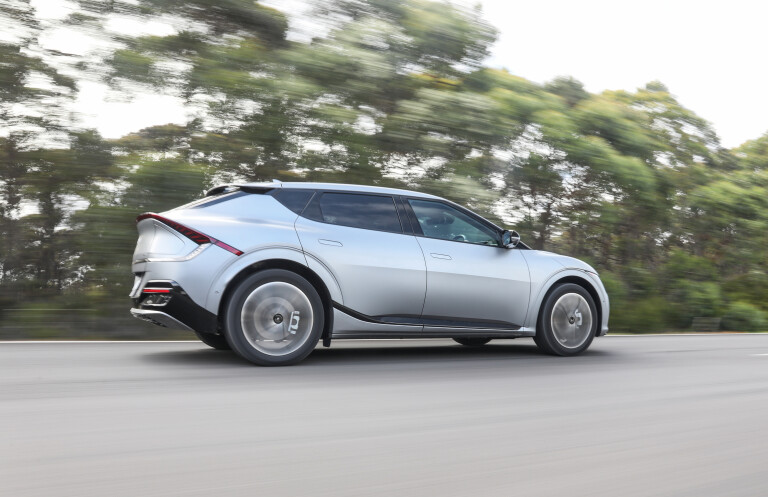
The important numbers
| Hyundai Ioniq 5 AWD | Kia EV6 GT-Line AWD | Polestar 2 Long Range Single Motor | |
|---|---|---|---|
| Price (before on-road costs) | $75,900 | $82,990 | $64,900 (+$6000 Optional Plus Pack) |
| Body | 5-door hatchback | 5-door hatchback | 5-door hatchback |
| Drive | all-wheel | all-wheel | front-wheel |
| Front motor output | 70kW/255Nm | 74kW/255Nm | 170kW/330Nm |
| Rear motor output | 155kW/350Nm | 165kW/350Nm | N/A |
| Combined power | 225kW | 239kW | 170kW |
| Combined torque | 605Nm | 605Nm | 330Nm |
| Transmission | single-speed reduction gear | single-speed reduction gear | single-speed reduction gear |
| Range | 430km (WLTP) | 484km | 510-542km (WLTP) |
| Battery capacity | 72.6kWh | 77.4kWh | 78kWh |
| Energy usage (WLTP) | 19kWh/100km (WLTP) | 18kWh/100km | 17.1kWh/100km (WLTP) |
| Charging capacity | 350kW @ 800V | 350kW @ 800V | 150kW @ 400V |
| 0-100km/h (tested) | 5.3sec | 5.1sec | 7.5sec |
| Top speed (claimed) | 185km/h | 188km/h | 160km/h |
The Polestar 2’s liftback-sedan body style is the obvious odd-one-out here. Exuding executive-style handsomeness, it’s the narrowest, lowest and shortest vehicle in our group. All three fall within a length spectrum spanning just 89mm, however, and the Polestar’s high-riding stance is influenced by the world’s obsession with SUVs as much as Korea’s elevated crossovers.
Also clear, when viewing the Ioniq 5 and EV6 side by side, is the freedom a skateboard battery architecture gives designers. They are twins under profoundly different skins.
The Hyundai sports taut angles, a steeply raked C-pillar, and pixelated light graphics that suggest the chief designer was suffering from a bout of Atari Pong nostalgia. The Kia opts for a sleek, dynamic aesthetic with sweeping curves, a gently declining roofline, and a ducktail-lidded rear that does a neat impersonation of an Aston Martin DBX. What they do share are relatively stubby bonnets (with clamshell lids) and short overhangs.
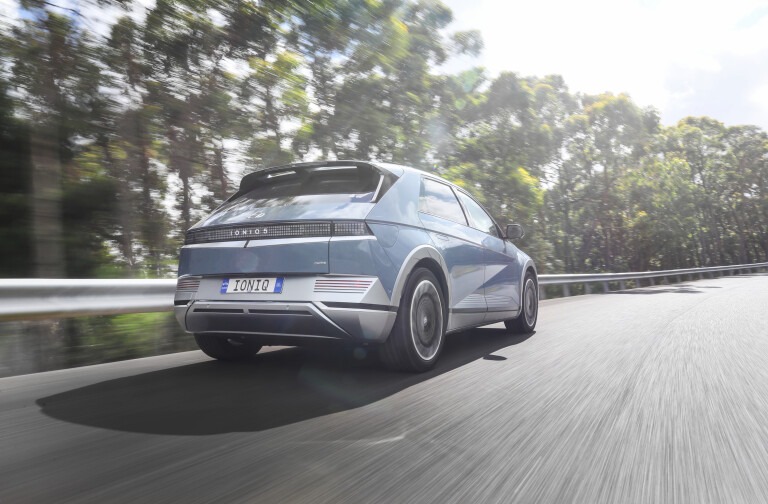
Comfort and Space
It’s lightness and darkness when comparing interiors, too – quite literally. Hyundai equips the Ioniq 5 with a panoramic sunroof, which, with the blinds parted, beams light into a cabin already brightened by an off-white trim complemented by varying shades of greys (with darker tones optional). Combined with the wide, spacious interior, it’s possibly as close as you can get to an alfresco experience in a fully enclosed car; you half expect someone to come and serve you a coffee.
A low, horizontal dash architecture contributes to the sense of roominess – almost shelf-like in the way it seems to serve only to support the dual digital displays (and a conjoining pinboard). The walk-through front cabin is divided by a sliding centre console, which frees up more space between the front occupants if its upper armrest section is lifted upwards. This also allows easier access to the lower section that can hold small bags and incorporates a wireless phone charging tray. A 9.0-litre pull-out glovebox competes for the honour of standout storage feature.
The Ioniq 5’s panoramic sunroof beams light into a cabin already brightened by an off-white trim … it’s possibly as close as you can get to an alfresco experience in a fully enclosed car

The no-alternative blackness of the EV6’s interior is particularly palpable after moving across from the Hyundai; it’s compounded by a regular-size sunroof that’s enforced by the sloping roof (but at least openable). Yet rather than depressing sombreness, a sporty vibe resonates throughout the cabin.
Kia’s interior designers have taken a notably more driver-oriented approach compared with their Hyundai counterparts, with the infotainment section of the curved dual display, digital climate/infotainment control panel, and even the starter button all angled towards the EV6’s hot seat. The distinctive, stapler-shaped centre console similarly doesn’t intersect with the dash but it’s immovable, creating a more traditional cockpit arrangement.

Storage is equally handy; just differently presented. Cup holders are integrated longitudinally into the centre console, for example, whereas the Ioniq 5 pairs them side by side in the front portion of the lower console. The EV6 has a more conventional glovebox hatch opening but there is still a large space inside.
Kia’s interior designers have taken a notably more driver-oriented approach compared with their Hyundai counterparts
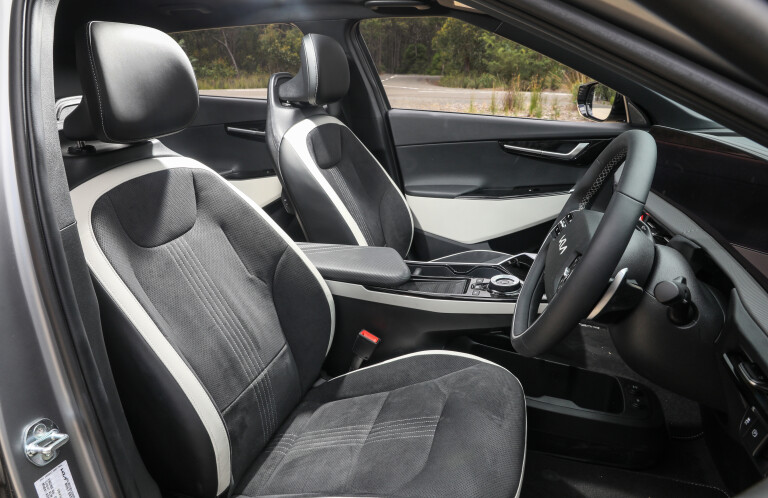
There’s an understated classiness to the Polestar’s interior – typically Scandinavian in its uncomplicated yet stylish design, logical layout, and application of complementary, tactile materials. Impressive build quality gives the Polestar at least one key advantage over a Tesla Model 3.
The high and prominent centre console may shrink space psychologically in a cabin that is already physically narrowest here, but front occupants are hardly cramped and the Plus Pack’s vegan-friendly fabric seats tick off support and comfort. The pack also adds a full-length glass roof, though with no blind/shade option the cabin is permanently exposed – something for owners to consider on scorching days.
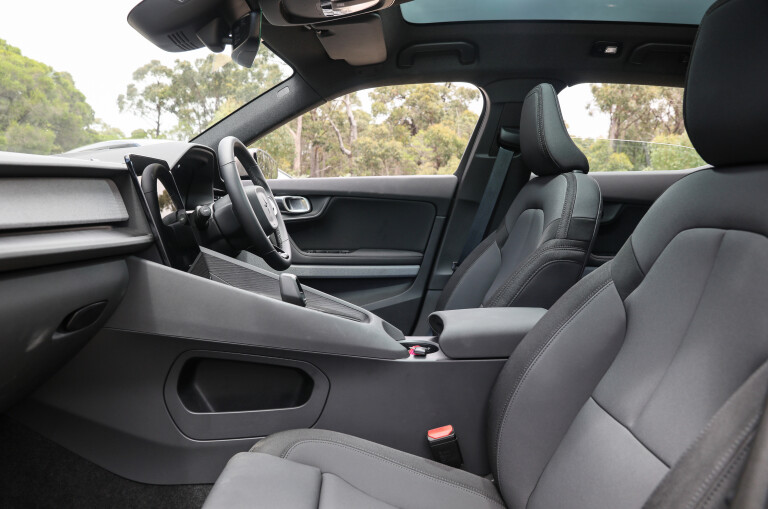
Polestar follows Volvo’s penchant for portrait touchscreens but presents a larger, 11.2-inch screen in a floating tablet design rather than the integrated 9.0-inch displays found in its parent brand’s models. It houses an Android operating system co-developed by Volvo Group and Google that, while having the potential to alienate Apple diehards, offers an interface with crisp graphics, a simple main menu split into quadrants and built-in Google services courtesy of an embedded sim. Those services are complimentary for the first three years of ownership before fees kick in.
The high centre console may shrink space psychologically in a cabin that is already physically narrowest here, but front occupants are hardly cramped
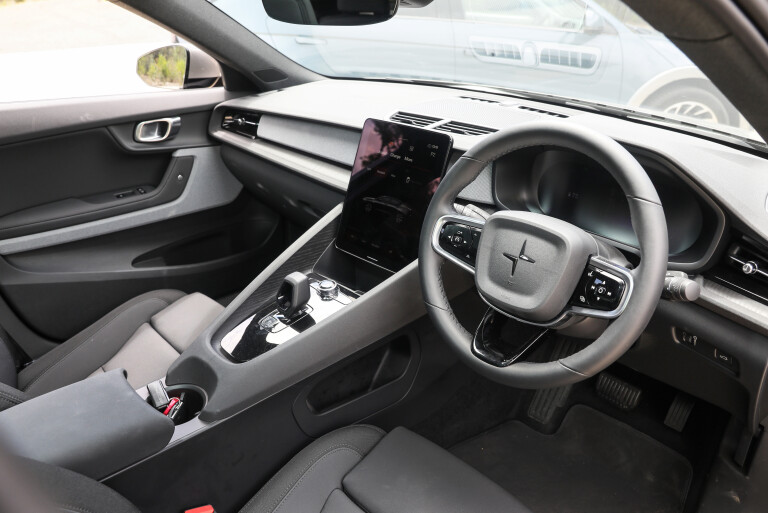
It’s a slightly more sophisticated presentation than the identical interfaces used by Hyundai and Kia, and intuitive (at least once it’s been discovered that the climate controls are accessed by swiping upwards).
Future Polestars will also utilise space-friendly battery floors; in the interim, the Polestar 2’s cabin can’t escape the compromises brought by the multi-drivetrain CMA platform shared with the Volvo XC40 compact SUV (and upcoming Volvo C40 Recharge).
A transmission tunnel, while not wasted as it packages part of the battery, realistically makes the Polestar a four-seater. The shortest wheelbase by some margin in this test predictably results in the least rear legroom of the group, if far from being a no-go zone for adults.
If the Polestar’s rear space is about on par for mid-sized vehicles, the back seats of the Ioniq 5 and EV6 are from a whole segment up in terms of roominess.

The Hyundai, with its limo-rivalling three-metre wheelbase, slightly leads the Kia on legroom. Both have fully flat floors and will fit three adults across, if necessary, while their rear seatbacks also feature recline adjust. The Hyundai’s rear bench adds an electric sliding function, though the Kia scores an arguably bigger convenience: an under-bench 240V socket that allows larger devices such as laptops to be charged on the move. It’s curiously missing from the Hyundai as it’s available on the Ioniq 5 in other markets.
Both Korean crossovers share exterior vehicle-to-load capability, whereby the charging port can double as a portable power source via an adaptor. Owners can set a limit on battery usage via the central touchscreen to ensure they’re not left stranded with insufficient range.
The Hyundai, with its limo-rivalling three-metre wheelbase, slightly leads the Kia on legroom
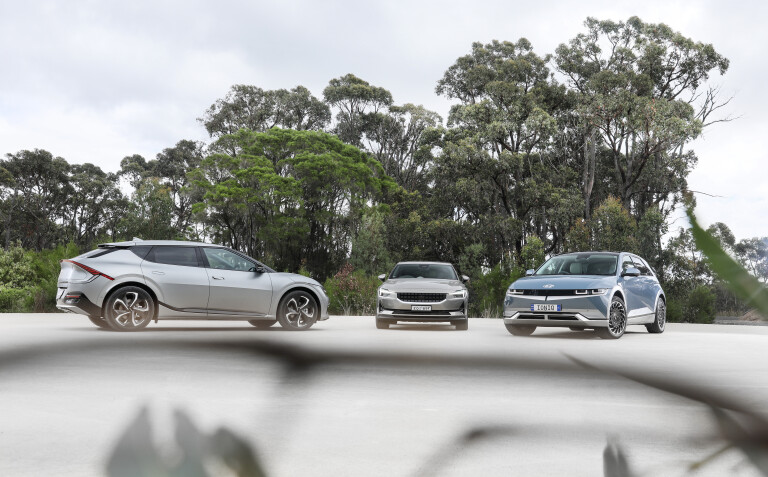
Vehicle dimensions and practicality
| Hyundai Ioniq 5 AWD | Kia EV6 GT-Line AWD | Polestar 2 Long Range Single Motor | |
|---|---|---|---|
| L/W/h | 4635/1890/1605mm | 4695/1890/1550mm | 4606/1985/1479mm |
| Wheelbase | 3000mm | 2900mm | 2735mm |
| Front trunk space | 24L | 20L | 35L |
| Boot space | 527L (min)/1587L (max) | 480L (min)/1260L (max) | 405L (min) |
| Weight | 2100kg | 2105kg | 1994kg |
| Braked towing capacity | 1600kg | 1600kg | 1500kg |
Theoretically, the Polestar 2 Long Range Single Motor – the most efficient of the line-up and owning the biggest battery here, just, at 78kWh – offers the most range to work with: up to 515km based on the same WLTP 'High' test cycle quoted by Hyundai and Kia.
Kia’s EV6 is next with a respectable figure of 484km, which – through its slightly larger, 77.4kWh battery – gives it a handy 54km advantage over its 72.4kWh twin.

Rear-drive versions of the Kia and Hyundai are rated with higher WLTP ranges: up to 528km for the base EV6, labelled Air, and up to 451km for the entry Ioniq 5.
The real-world rule of thumb is to treat EV WLTP figures with a pinch of salt, and for longer drives to carefully assess routes for the presence of charging stations.
Find a 350kW DC ultra-rapid charger, though, and the Ioniq 5 and EV6 battery packs can be replenished faster than any other EV currently available. That – in theory – includes the Porsche Taycan, the only other electric car in the world to front-up with high-voltage charging capability: 800V to the industry standard 400V.

AC charging specifications
| Hyundai Ioniq 5 AWD | Kia EV6 GT-Line AWD | Polestar 2 Long Range Single Motor | |
|---|---|---|---|
| AC charger port | Type 2 | Type 2 | Type 2 |
| AC charging capacity | 10.5kW | 10.5kW | 11kW |
| Charging time (11kW, up to 100%) | Approx 6hr 6min | Approx 7hr 20min | Approx 8hrs |
Halving recharging time as quick mathematics suggest, the Korean EVs can jump from 10 to 80 per cent battery state of charge in 18 minutes. Polestar quotes 35 minutes for the same increase. The catch is that while ultra-rapid chargers are starting to expand in Europe, they’re still thin on the ground in Australia.
The Kia and Hyundai share a great power-nap feature for passing recharging time, though: “relaxation” front seats that recline extensively like the airline industry’s 1990s precursors to fully flat business class beds.
DC charging specifications
| Hyundai Ioniq 5 AWD | Kia EV6 GT-Line AWD | Polestar 2 Long Range Single Motor | |
|---|---|---|---|
| DC fast charger port | CCS | CCS | CCS |
| DC fast charging capacity | 350kW | 350kW | 155kW |
| Charging time (50kW, up to 80%) | Approx 62min | Approx 73min | Approx 72min |
| Charging time (115kW, up to 80%) | Approx 29min | Approx 31min | Approx 35min |
| Charging time (350kW, up to 80%) | Approx 18min | Approx 18min | N/A |
On the Road
While EVs are predominantly charged at home, every model here is worth enjoying beyond city limits and daily commutes. Some elements of the Ioniq 5 and EV6 driving experiences are as chalk and limestone as might be anticipated with two platform pals.
The levels of regenerative braking are adjusted identically via paddles and both include a one-pedal-driving setting called i-Pedal.
Steering is identically geared at 2.7 turns lock to lock and the dual motors operate in the same manner – focusing on one electric motor in regular driving to maximise efficiency; combining both when extra traction is needed or demanded.
Both have Sport modes – selected by a convenient steering wheel button – that engage both motors for maximum, all-wheel-drive thrust.
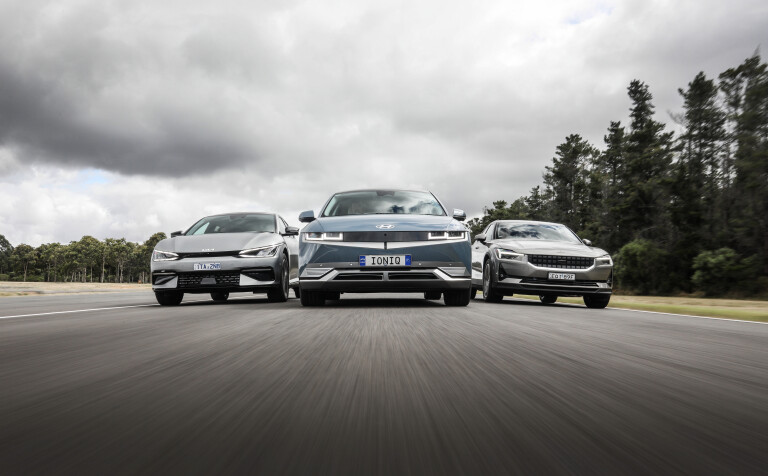
But there are nuanced differences; all favouring the Kia. Aside from a local suspension tuning program that overcame COVID-19 complications more successfully than Hyundai Australia’s version, the EV6 is said to be the first vehicle from a mainstream maker to be fitted with sophisticated, variable-force dampers from ZF Sachs.
While the dampers bring a firmer low-speed ride than the Ioniq 5 (also shod with 20-inch wheels), the EV6’s suspension never becomes crashy and brings benefits at higher speeds – a generally more settled ride and slightly more disciplined body control all round.
The Ioniq 5 can exhibit vertical fidgetiness when trying to deal with bumpier country roads and is less successful at absorbing bigger hits than the Kia. The Hyundai carves through corners confidently with an abundance of grip and traction; the Kia matches that while bringing extra composure in fast directional changes and over mid-corner bumps.
The EV6 is said to be the first vehicle from a mainstream maker to be fitted with sophisticated, variable-force dampers from ZF Sachs

It also feels that bit more involving, a sense enhanced by the fact you sit in the EV6’s driver’s seat rather than on it, as is the case with its platform pal. The Kia is also the only EV here to provide a head-up display and it’s complemented by augmented-reality navigation featuring active directional chevrons.
Driver appeal is also found in the Polestar, where the engagement level succeeds in being higher than that of the XC40 electric SUV and on a par with the EV6.
The Swedish sedan’s steering is the most direct here, complementing the taut chassis set-up. Its weighting can be adjusted via the central touchscreen, though the default setting feels more linear than Light or Firm.
And in another departure from your regular Volvo, there’s an ESC Sport mode. Lift-off regen force can also be changed via the same driving modes menu, catering to varying preferences. We found the default setting best for one-pedal driving around town; Low is good for tourist roads, still making the brake pedal largely redundant; Off – essentially a coasting mode – is ideal for freeways.
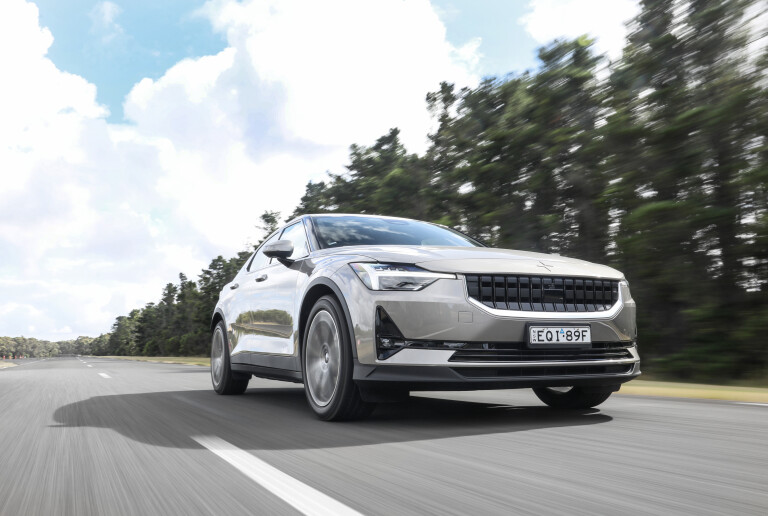
If performance feels relatively slow after driving the Hyundai and Kia, the Polestar is enjoyably effortless in isolation, and opting for the faster Dual Motor model doesn’t force buyers outside the boundaries of this comparison’s price bracket even with key option packs included.
The Dual Motor’s claimed 4.7-second 0-100km/h time would make it the quickest car here, too, half a second clear of the Ioniq 5 and EV6 and well ahead of the Single Motor Polestar 2’s claimed 7.4 seconds.
Our performance testing revealed the Kia to be faster than its claim, however, achieving 5.1 seconds against 5.3sec for the Hyundai and 7.5sec for the Polestar.
Performance and handling specifications
| Hyundai Ioniq 5 AWD | Kia EV6 GT-Line AWD | Polestar 2 Long Range Single Motor | |
|---|---|---|---|
| 0-100km/h (claimed) | 5.2sec | 5.2sec | 7.4sec |
| 0-100km/h (tested) | 5.1sec | 5.3sec | 7.5sec |
| Top speed (claimed) | 185km/h | 188km/h | 160km/h |
| Suspension | MacPherson strut (f) / multi-link (r) | MacPherson strut (f) / multi-link (r) | MacPherson strut (f) / multi-link (r) |
| Front brakes | 345mm ventilated disc | 325mm ventilated disc | 345mm ventilated disc |
| Rear brakes | 345mm ventilated disc | 325mm solid disc | 320mm ventilated disc |
| Tyres | 255/45 R20 105W (f & r); Michelin Pilot Sport EV | 255/45 R20 105H (f & r); Continental Premium Contact | 245/45 R19 (f & r); Michelin Primacy 4 |
The Polestar’s ride joins the Kia in the firm-yet-comfortable camp, though road noise is quite excessive – certainly when compared with its quiet-natured rivals. There were no surprises when our decibel-meter registered 71.00dB versus 68.05dB and 67.25dB for the Ioniq 5 and EV6, respectively.
Let’s hope Hyundai and Kia find ways to increase supply, because the Ioniq 5 and EV6 are worthy of attention for more than head-turning design
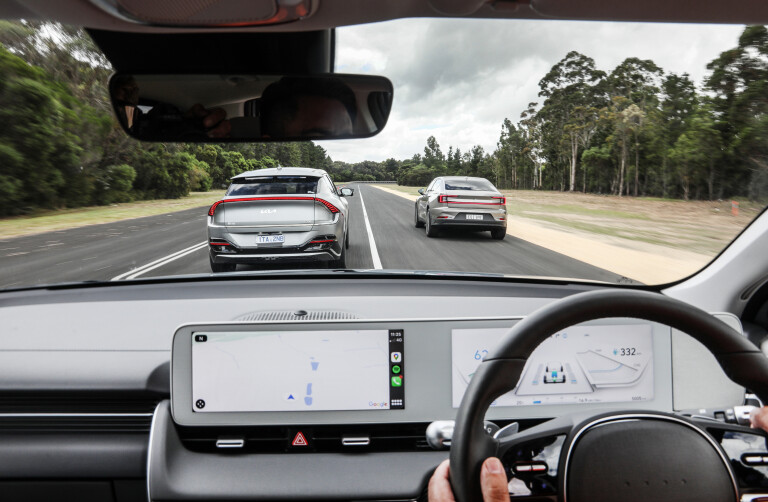
The ownership numbers
| Hyundai Ioniq 5 AWD | Kia EV6 GT-Line AWD | Polestar 2 Long Range Single Motor | |
|---|---|---|---|
| Warranty | 5-year/unlimited km | 7-year/unlimited km | 5-year/unlimited km |
| Battery Warranty | 8-year/160,000km | 7-year | 8-year/160,000km |
| Servicing | $220-$804 per visit (every 12 months/15,000km) | $87-$343 per visit (every 12 months/15,000km) | Complimentary for 5 years/100,000km (every 24 months/30,000km) |
VERDICT
Showrooms are where Polestar needs to make the biggest noise, and the brand can’t be accused of lacking confidence with its first shot at the all-electric segment. It’s also a bold move to make certain driver aids optional when safety has been the parent company’s key pillar for more than 90 years. That helps deliver the most affordable EV in this group, however, and there are attractions beyond pricing – such as the Polestar 2’s elegantly designed interior, intuitive Android infotainment system, or its Tesla-matching app functionality and over-the-air update capability. It’s also the only choice of this trio if you want your new EV immediately, avoiding indefinite waiting lists.
Let’s hope Hyundai and Kia’s Australian arms can find ways to increase supply, because the Ioniq 5 and EV6 are worthy of attention for much more than head-turning exterior design. They bring industry-leading fast-charging capability as well as clever and genuinely useful bi-directional charging technology, while the scale and ambition of their cabins – within similar dimensions to the Polestar – showcase the clear advantages of a dedicated battery vehicle platform.

The EV6 GT-Line AWD’s premium over the equivalent Ioniq 5 is larger than may have been anticipated, though conversely, only the EV6 range offers a variant eligible for the country’s best electric vehicle incentives.
Stick to comparing the most expensive versions, however, and the Kia builds its case for victory. Edging the Hyundai with its additional tech, a bigger audio system, longer range, slightly quicker pace, a longer factory warranty and more sophisticated suspension, the EV6 also throws in the bonus of a more immersive driving experience.
Sometimes hype is justified.
SCORING
Kia EV6 GT-Line AWD: 9/10
Hyundai Ioniq 5 AWD: 8.5/10
Polestar 2 Long Range Single Motor: 8.0/10



COMMENTS